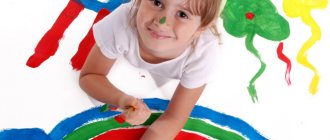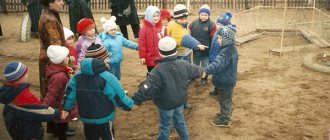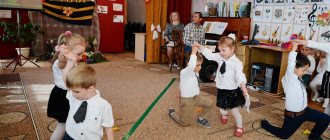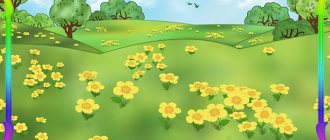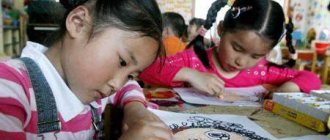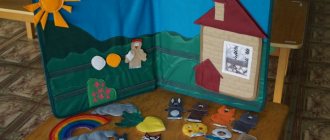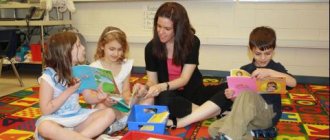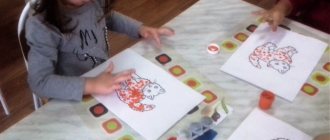Goals and objectives of open classes to familiarize yourself with the outside world in kindergarten
The content of the program for familiarization with the outside world in a preschool educational institution (DOU) is determined by the Federal State Educational Standard (FSES) and has the following goals:
- introducing kids to properties and matter (water, sediment, earth, fire, etc.);
- developing children’s ideas about relationships in nature and a healthy lifestyle;
- development of thinking, intelligence, attention, that is, the skill to compare, analyze and draw conclusions regarding the observed object (for example, comparison of liquid in different states of aggregation - snow, water, steam);
- training the skill of working according to a scheme, plan (for example, according to instructions during an experiment on seed germination);
- practicing the ability to work individually and in groups;
- encouraging children to express their point of view with evidence;
- speech development;
- nurturing interest and respect for the native land.
Getting to know the outside world and the nature of your native land is the basis of patriotic education
The achievement of the set goals is facilitated by the implementation of the following tasks:
- practice observing the environment in different ways (conducting experiments, obtaining information from books, encyclopedias);
- teach to build hypotheses regarding the properties of natural phenomena (for example, we look at surrounding objects, determine their color, we come to the conclusion that the air is invisible and colorless);
- promote the formation of orderly mental operations, as well as the ability to express one’s thoughts in a reasoned manner;
- develop monologue and dialogic speech;
- expand children's vocabulary;
- cultivate a respectful attitude towards comrades in joint work and play;
- increase the level of independence when performing tasks in class;
- instill interest in experimental activities;
- cultivate accuracy in work.
If we talk about the goals and objectives of an open lesson, then it should be noted that such events are aimed primarily at:
- presentation of the variety of methodological techniques used by the teacher in the classroom;
- demonstration of the knowledge, skills and abilities of the children acquired during the work on studying the software course.
It is these components that determine the combination of techniques used in the work.
An open lesson differs from a regular lesson in that the teacher chooses interesting techniques to conduct it, trying to demonstrate everything that the kids have already learned.
Table: goals and objectives of an open lesson on studying the surrounding world for different ages
| Age category | Goals | Tasks |
| First junior group |
|
|
| Second junior group |
|
|
| Average |
|
|
| Older |
|
|
| Preparatory |
|
|
Getting to know the world around you
Familiarizing children with the world around them forms in children a holistic perception and understanding of various objects and phenomena of the surrounding reality.
Provides significant changes in the mental development of children. In the process of becoming acquainted with nature, children form an idea of the living and inanimate world, of the interrelationship of the interdependence of objects and natural phenomena.
In the section of the site, familiarization with the outside world in kindergarten for different groups, contains many interesting publications for educators on teaching children on various topics:
- Summary of an open lesson on familiarization with the environment and development of speech with children of the senior correctional group
- Outline of joint educational activities to familiarize yourself with the outside world
- Summary of organized educational activities familiarization with the surrounding world on the topic “Water”
- Lesson on the surrounding world in the middle group of kindergarten on the topic “Vitamins”
- Summary of an open integrated lesson on familiarization with the environment in kindergarten “Visiting the Mistress of the Copper Mountain”
- Summary of a lesson on familiarization with the outside world for children of the junior group of the kindergarten “Heroes of Folk Fairy Tales”
- Summary of a lesson on familiarization with the outside world in the senior group of kindergarten on the topic “Paper Collector”
- Organization of cooperation between children and adults in the process of interaction with people, culture and the outside world
- Technological map for familiarization with the outside world in kindergarten for children of the preparatory group on the theme “Earth Day”
- Summary of the final lesson on familiarization with the environment in a preparatory group for school on the topic “Space travel”
- Lesson on the world around us in kindergarten “The forest is full of secrets and wonders”
- Synopsis for a lesson on familiarization with the outside world at the preschool educational institution “Siege of Leningrad”
- Summary of a lesson on familiarization with the outside world in kindergarten on the topic “The child’s right to a first name, patronymic and last name”
- Summary of educational activities for familiarization with the outside world, middle group “Birds in winter”
- Lesson on the environment and ecology in kindergarten on the topic “Wild and domestic animals”
- Summary of a lesson on familiarization with the outside world, joint search and research activities
- Planning lessons on “The World Around You” at a preschool educational institution
- A comprehensive open lesson to familiarize children with the world around them “Fun Train”
- Summary of educational activities for familiarization with the outside world in the second junior group of the kindergarten “Walk in the Forest”
- Summary of the lesson on familiarization with the environment, second junior group
Familiarizing children with the world around them as a means of developing the horizons of older preschoolers. The main task of classes to familiarize themselves with the world around them is to form in children a holistic perception and understanding of various objects and phenomena of the surrounding reality.
Familiarizing preschoolers with the world around us is a means of developing in their minds realistic knowledge about the world, based on sensory experience and education of the correct world. The world around us is large and diverse. It includes the social world of people, the world of nature, and the world of objects created by man. Therefore, it is necessary to help the child build a holistic picture of the world, which synthesizes cognitive and aesthetic aspects, as well as moral norms of relations between people. The child’s idea of the objective and social world should be unified and holistic. It is important that the knowledge acquired by the child is not abstract, and that he understands and recognizes himself as part of the world around him.
Classes to familiarize yourself with the environment include familiarization with the phenomena of social life; familiarization with the objective world created by man; familiarization with the phenomena of living and inanimate nature. During classes, children are introduced to a certain type of properties, connections and relationships, specific to each of the four main areas of correctional pedagogical work highlighted in the program: Man, Object World, Living Nature, Inanimate Nature.
The subject Familiarization with the surrounding world has certain features not only in content, but also in teaching methods. The main characteristic feature of the subject “Acquaintance with the world around us” is that each topic is studied throughout the entire academic year. This is necessary in order to systematically develop children’s skills and behavior habits, to form in them the correct attitude towards the surrounding reality. Returning to the same topic throughout the year is also advisable in connection with seasonal changes in nature, as well as significant events in the life of our country.
Methods and techniques used in open classes to familiarize yourself with the environment in kindergarten
For an open lesson, the teacher should select only techniques that have been proven in practice - this is the main condition for a successful lesson. If we talk about work methods when studying a course on familiarization with the environment at a preschool educational institution, the list is quite extensive.
Visibility
Since this technique involves the active interaction of thinking, perception and speech, it is certainly considered one of the most productive and can be used in several forms.
Observation
A technique that allows one to identify essential features in phenomena and objects and establish cause-and-effect relationships between the objects being studied. In kindergarten, observation can be:
- short-term (for example, when children of the second youngest group monitor the speed of snow melting in a warm room);
- long-term (for example, children in the preparatory group watch the germination of beans every day).
Children enjoy participating in observations
One of the forms of implementing this technique is conducting experiments. Starting from the middle group (if the level of general development of the children allows, then from the second youngest), children participate in experimental activities.
There shouldn’t be a lot of experiments in the lesson, otherwise they will turn from an unusual and exciting type of work into an uninteresting routine.
Table: examples of experiments for open classes to get acquainted with the outside world
| Group | Lesson topic | Experience name | Goals | Description |
| Second youngest | Precipitation | "The ice is melting" | Introduce the property of water to freeze in the cold and thaw in the heat. |
|
| Average | Environmental pollution | “How soil pollution occurs” |
|
|
| Older | Wind | "Why does the wind appear" |
| Invite children to blow on a strip of paper lightly, strongly, moderately. Conclusion: if you blow strongly on a strip of paper, the air movement will be very fast, you will get a “breeze”, and if you blow lightly, the air movement will be weak, you will get a “breeze”. Wind is the movement of air. |
| Preparatory | Migratory birds | "Why do birds fly" |
| Children look at the birds that have flown to the site. Conversation with students.
|
Video: experimental activity in a lesson on familiarization with the outside world on the topic “Light and Shadow” in the junior group
Demonstration
Another option for using visibility, which is implemented in impressions:
- objects (plants, pictures of animals, agricultural tools, etc.);
- method of action (this technique is especially important when performing experiments - children perform all manipulations only after the teacher shows and explains each step of the experiment);
- pictures, presentations, educational videos, etc. (this is how the teacher introduces children to phenomena with which direct interaction is impossible, for example, the animal world of the Arctic).
Children also take part in demonstrations, presenting the results of their experiments, for example, water colored with food coloring
This is interesting. Taking into account the technological nature of our time, any demonstration using technical teaching aids (TST) makes the learning process more entertaining and attractive for children.
Verbal teaching techniques
This is an integral methodological component of working with children in kindergarten.
Conversation
Dialogue with children contributes to a stronger consolidation of acquired knowledge, and also develops the speech of little wards and expands their vocabulary. The conversation in younger groups takes the form of short answers to the teacher’s questions (for example, “What time of year is it now?”, “Month?”, “Weather?”), in older groups the answers become more detailed, and the wording of the questions has a problem-oriented focus (for example , “What do you know about the life of birds in winter?”).
Story
An effective technique for introducing new factual material. However, in an open lesson, you shouldn’t get too carried away with it: after all, the result of the work is assessed not by the teacher’s ability to tell an interesting story, but by the knowledge, skills and abilities that the students receive. Therefore, the story of children (in older groups) will be more advantageous.
Any practical actions in class are accompanied by verbal techniques
Reading
In older groups, if the kids already know how to read, during the lesson you can give the task to read short (1-2 simple sentences) notes about a particular phenomenon or object being studied. For example, when studying domestic animals, children can read about the benefits of each of them (“Cows give milk,” “Chickens lay eggs,” etc.).
Poems, riddles
This is a great motivational technique that gets kids ready to work. It fits especially well into the initial stage of the lesson as an update of basic knowledge. For example, when studying the topic “Autumn” in the middle group, children can be asked to solve riddles:
- Leaves fly off the branches, Birds fly away to the south. “What time of year?” we ask. They will answer us: “This is...” (Autumn).
- The wind will call the cloud, the cloud will float across the sky. And over the gardens and groves there is a cold drizzle... (Rain).
- In the gray sky low, clouds move close, covering the horizon. It will be raining. We took... (Umbrella).
- The clouds are gathering, Howling, blowing. Prowls the world, sings and whistles. (Wind).
This is interesting. In younger groups, it is better to choose riddles with endings - this makes it easier for the children to guess the answer.
As riddles, you can offer everyday situations, the solution to which will be one or another picture (for example, in the event of a fire, we call the fire department)
Many teachers choose a poem on the topic as an epigraph for a lesson. This technique not only helps children get involved in work faster, but also contributes to the development of children’s speech, since sounding rhyming lines teach children to correctly place stress in words and enrich their vocabulary. For example, when considering the topic “Wintering Birds” in a senior group, the selection could be like this:
- White grains are pouring into the garden, and the sparrows are flying to dinner. They sat down in a flock and began pecking... What kind of food they could not understand. This is not cereal, not cottage cheese, This is cold white snow.
- Here is a crow sitting on the fence. All the barns have been locked for a long time. All the convoys passed, all the carts. It's time for bad weather. She's fussing about on the fence. Woe to her. Real grief. After all, the crow doesn’t have a grain And there’s no defense against the cold...
- A magpie gallops through the spruce forest, hitting the snowstorm with its tail. It’s cold for a magpie to jump around without a fur coat. The magpie is crying, but there is nowhere to take it.
- Bullfinches on branches decorated with snow fringe. Ruddy apples grew in winter. Apples on an apple tree scurry merrily. Ice cream caterpillars are pecking at apples.
Fairy tales
A technique that is relevant for preschoolers of all ages. In an open lesson, its use not only perfectly motivates students to work, but also brings originality to the teacher’s methodological arsenal. It should be remembered that everything is good in moderation, so the fairy tale:
- must be on the topic (the legend about why bears fall asleep in winter will not be suitable for studying the topic of wintering birds - the roll call turns out to be too distant);
- differs in laconicism and simplicity.
Below we give an example of a fairy tale for children of senior preschool age (when studying the topic of different states of aggregation of water).
One day the bunny decided to run away from home. He ran far away, but still knew the way back. Then he sees a stream running. And the stream says to the little hare: “Let’s go and run a race.” Whoever runs to the forest faster wins.” The bunny agreed. So they ran to the forest.
They run, run, run, and then the bunny doesn’t see the stream and shouts: “Where are you, stream?” And the stream replies: “I evaporated and turned into fog. Well, let's run on. Where there is fog, there I am.” And they ran. They run, run, run, and then the bunny did not see the fog and shouted: “Where are you, stream that is fog?”
“I’m here,” says the stream, “I’ve turned into a cloud. Well, let’s run!”
The perplexed bunny and the stream continued on their way. They ran and ran, and then the bunny didn’t see the stream. The bunny shouts: “Where are you, stream, fog, cloud?” The brook replies: “I turned into rain. Well, let's run." And they ran, but suddenly the rain stopped, and again the bunny shouted: “Where are you, stream, fog, cloud, rain?” The brook replies: “I’m here, under your paws. The rain stopped, and I became a stream again.”
The stupid hare and the stream ran together to the forest. But the hare didn’t understand anything.
Mikhail Prishvin
https://nsportal.ru/detskiy-sad/okruzhayushchiy-mir/2014/01/29/skazki-o-vode
If the plot allows, then the fairy tale can be supplemented with a demonstration
Video: verbal techniques in a lesson on getting to know the outside world on the topic “Journey to the Land of Health”
Gaming techniques
Play is the leading activity of preschoolers. Particular attention should be paid to the use of games in the classroom, because this technique allows you to present information faster and better, practice it and consolidate it. That is why games can be used at all stages of the lesson. We are talking not only about didactic games, that is, those with an educational goal, but also about active games aimed at maintaining health. As for the latter, they are used as physical education minutes in the middle of the lesson.
Most children of any age enjoy playing with water.
Some experiments within the framework of observation in classes to get to know the outside world are of a playful nature, so methodologists do not recommend piling up similar techniques within one lesson.
Table: didactic games in an open lesson on getting to know the outside world for preschoolers of different ages
| Age | Name of the game (lesson topic) | Target | Description |
| Junior groups | “Collect a Picture” (“The City We Live in”) |
| We distribute envelopes with puzzles depicting a local landmark to the children in pairs. The kids’ task is to put together a picture (if there are not enough mini-groups, then the task can be completed at speed). |
| “Floats or Sinks” (“Properties of Water”) |
| We take toys from different materials, pieces of paper, etc., put them in the water and determine whether it sinks or floats. Then we divide all items into 2 categories. The task can be completed individually or in pairs. | |
| Average | “Find what I’ll show you” (“Vegetables, fruits”) | To consolidate children's knowledge about the names and appearance of vegetables and fruits. Note: the task can be complicated by adding models of exotic fruits. | We show for a short time one of the objects hidden under the napkin, remove it and give the task: “Find the same vegetable or fruit under another napkin and remember what it is called.” The kids work in turns until all the fruits and vegetables under the napkin are named. |
| “What kind of tree?” (“Flora world of the native land”) |
| The teacher describes a tree, children whose cards show 3-4 trees must name the one they are looking for. To make it more difficult, the game can be played against time. | |
| Senior groups | “Choose Right” (“Know Thyself”) | Form ideas about the structure of the human body. | Children choose from a set of toys the character that is most similar to a person, and explain their choice (there is a torso, arms, legs, etc.). |
| Interactive game “The Fourth Wheel” (“Insects”) | Teach children to unite representatives of the same class according to life cycle stages and external similarities. | The teacher shows the children slides with images of insects in different stages of development (butterfly, fly, ladybug and caterpillar). Students must find an extra object (a caterpillar, since the rest are adults). |
Understanding the world around us in kindergarten
Consultation for kindergarten teachers.
Understanding the world around us through observations (from work experience) Purpose: This material is recommended for young beginning teachers working with children from 3 to 7 years old, as well as for interested parents. Description of the material: When introducing preschoolers to the world around them, a special place is given to the observation method. How to make a walk interesting? How to conduct observation with children? What techniques can be used? Do you know the game "Pathfinders"? If you are interested, then this material is for you. Goal: to help educators organize and conduct observations with preschool children. Author: Marina Vitalievna Orlova, teacher of the first qualification category, MADOU kindergarten “Harmony”, structural unit of kindergarten No. 22 “Nadezhda”, city of Novouralsk, Sverdlovsk region.
When introducing preschoolers to the world around them, a special place is given to the observation method.
Observation plays a big role in the all-round development of a child:
1. In the process of observing the surrounding nature, favorable opportunities are created for a variety of practical activities of children, for the formation of humane feelings towards representatives of the animal and plant world. 2. Direct perception of natural objects and their diversity have an emotional impact on children, causing them surprise and joy, which thereby improve aesthetic feelings. 3. Observation of objects and natural phenomena is impossible without movements, which means that the use of this method when getting acquainted with nature contributes to the physical development of children. 4. In the process of observations, figurative ideas accumulate, which provide reliable material for the formation of concepts. In a word, observations constantly enrich the child’s consciousness with new knowledge.
Main purpose of observations
– develop the ability to observe: not just look at an object, but see it in such a way that you can then clearly imagine this image in all its details.
This ability to see does not come by itself. What techniques do I use to achieve this goal in early and middle age?
In the fourth year of life, visual-figurative thinking appears.
Children's curiosity is clearly evident. It is very useful not to convey knowledge in a ready-made form, but to help the child obtain it on his own. How to do it? When thinking through observation, it is important to determine exactly what tasks it solves, to establish the sequence and techniques for managing children’s activities. The most effective techniques in the second junior group are: • organizing examinations with the object of observation, if this does not threaten the child’s health; • use of search actions; • child’s imitation of movements, sounds of objects, natural phenomena; • method of comparison. I will briefly discuss each of them. The examination technique is aimed at identifying sensory signs of a given object.
For example, while playing with sand, children learn about such properties of sand as color, flowability (wet sand can be used to make something, but dry sand cannot, it crumbles). While observing trees, we examine the bark with children, and they learn that it can be different: rough or smooth, warm or cold, hard, and has a smell. Search actions:
- Who heated the objects?
-Where does the stream flow from? - Who plays with leaves? etc. The technique of imitation of movements and sounds helps children to look more closely, listen attentively to an object, phenomenon and to catch such subtleties that “passed by” at the first observation.
For example, I suggest that children repeat the movements of a bird’s wings during flight, fold their palms and move them like a fish moves its tail, etc. In the second half of the year I begin to use the comparison technique .
As studies by psychologists show, preschool children master this technique.
Using comparison, they identify similarities and differences in objects and phenomena, their essential, main features. For example, compare the leaves of one tree with the leaves of another by color, shape, size. In the middle group
, the number of questions increases, children’s actions become more focused and deliberate.
Therefore, it is recommended to carry out long-term observations, that is, in the form of cycles. A single cycle is a series of interconnected observations of a specific object of living nature. Each of the cycle observations has: • its own content; • your goal; • does not repeat other observations, but is interconnected with them. What is the advantage of such observations? 1. The cycle is carried out over a long period of time - 1-2 observations are planned per week, which helps children develop interest in this natural object. 2. In the cycle, the amount of knowledge is distributed into “portions”, which ensures their gradual and more reliable assimilation. 3. The cycle of observations allows the child, through a sensory and independent way, to acquire a system of specific knowledge about the animals or plants that live in his neighborhood. The observation process itself begins with the fact that I invite the children to examine the object as a whole, so that they have a general idea of its shape, predominant color, nature of movements, etc. During the following observations, I organize the examination of the object in parts, focusing on only one detail. With this approach, the child gets used to concentrating his attention on the specified detail. To facilitate this, I use various techniques: 1. After looking at it once, I invite the children to close their eyes and imagine what they just saw. Then open your eyes again and clarify what you couldn’t see the first time. It is advisable to repeat this technique several times. 2. To consolidate the image of the observed object, I use a technique such as coloring black and white drawings. This can be done from memory or from nature. This helps children to carefully look at the details of objects, notice subtleties, and the desire to observe. 3. The development of thinking is facilitated by the use of analogy. Having collectively described an object or phenomenon, I invite the children to independently describe another object in the same order. I organize didactic games: “Find the same one”, “Guess the plant by description”, “Find what I describe”, etc. In the process of games, children acquire certain knowledge and skills: • remember the name of a natural object; • in plants – names of parts (root, stem, leaf, flower), learn to find them on other plants; • in trees: root, trunk, branches, leaves, fruits; • leaves are distinguished by shape (round, elongated, star-like), color (green, yellow, red), size (large, small), surface features (smooth, rough). At older preschool age,
children are able not only to accept a cognitive task set by an adult, but also to set it independently.
By the age of 5, a child has already formed a number of ideas about the environment and attitude towards it, which can serve as the basis for environmental education at this age. This is due to psychophysiological characteristics: the ability for logical thinking appears, the arbitrariness of the cognitive process increases, basic mental skills and operations are laid (comparison, analysis, generalization, classification). Children's curiosity clearly manifests itself. They often ask: “What is this?”, but I am in no hurry to answer, but try to make them figure it out themselves. I ask questions that stimulate children’s mental activity. For example, – Is this an inanimate or living object of nature? - How did you guess about this? – What does it feel like? - How does it move? – Does it leave any trace behind it? – Does it have eyes, a mouth, legs? Is it possible to see them? If not, why not? -What is this creature? -What other creature does it look like? – Are there others like them nearby? – What could happen if you step on it? -Where does it live? – Do you think it’s young or old? -Can it turn into something else? Thus, I help the child gain knowledge independently in the process of active mental activity. In this case, the child's question turns into goal formation. I only give advice and recommendations, together with him I carry out the necessary actions. The examination actions of children of this age become more conscious and are used mainly to verify the impressions obtained during observation. I widely use search actions. Children really like the game "Pathfinders" . The tasks for this game can be varied. For example, • I invite children to collect various pebbles, leaves (where they came from, what they look like); • Count how many objects of living and inanimate nature the children will find on the site; • Using a magnifying glass, look for traces of insect activity (these can be eaten leaves, passages of beetle larvae - carnivores under the bark of trees; • Find around you an object of living or inanimate nature, the name of which begins with the same letter as the child’s name. For example: Danil – tree, Lena – leaf, Marina – ant, Pasha – sand, Katya – stone, etc. • Smell an object blindfolded and guess what it is; • Determine by touch; • Find the most illuminated and the darkest place on the site, the warmest and coldest; • Find something sticky; • Find an object that is not related to nature; • Something that a bird would happily eat; • Find an object that reflects my mood. For formation ability to see, it is very important to maintain interest in observations. One of the most important ways to maintain interest is to use images of observed objects in classes on the development of speech, visual arts, cognition and even mathematics. By organizing observations in nature, I strive to ensure that children not only received a complete understanding of objects and phenomena, but could also express it in words. First of all, they must be able to name natural objects expressed by nouns and attributes of objects expressed by adjectives. The use of the various techniques that I mentioned above causes children to make judgments and inferences, which take the form of sentences, that is, a type of coherent speech. Walking, that is, direct communication with nature, arouses great interest among children. Playing with pebbles, sand, cones, and fallen leaves, children become inquisitive and have many questions. Observations provide material for working with parents, because children tell them about everything interesting, and they tell us. This is how a mutual conversation goes. So, step by step, I try to instill in children a caring, loving attitude towards the world around them.
We recommend watching:
Patriotic education of preschool children in kindergarten Consultation for preschool teachers. Classical music for children Environmental project in kindergarten. Middle group Business game for preschool teachers
Similar articles:
Observations of aquarium fish in kindergarten. Junior group
Observations of a bird in a cage in a kindergarten. Junior group
Observations of snow and water in kindergarten. Junior group
Observations of plants in kindergarten. Dandelion and coltsfoot. Junior group
Preparing an open lesson to familiarize yourself with the outside world at a preschool educational institution
Like a regular lesson in a preschool educational institution, an open lesson has a clearly timed structure.
- Updating basic knowledge or introducing the topic - 2–3 minutes. At this stage of work, motivational techniques are being developed. For example, telling a fairy tale and showing pictures in younger groups, or watching a presentation and solving riddles in older groups.
- The main stage of work, which takes from 20 to 25 minutes, includes observation, including conducting an experiment, and formulating a conclusion based on it. Physical education (finger or breathing exercises) is included in the same time frame.
If necessary, observation can be taken outside the scope of the lesson, leaving it as one of the stages of the walk, but for an open lesson such a division is not entirely convenient
- The final stage takes 2–3 minutes and involves a verbal assessment by an adult of the children’s work. In the senior and preparatory groups, children learn reflection, so they independently evaluate the effectiveness of the lesson specifically for themselves. In the senior group, another task is added to self-esteem - to assign points for the work of all team members together.
Conclusion: the structure of an open lesson does not differ from the structure of a regular lesson. This also applies to timing: in the first and second junior groups, familiarization with the outside world lasts 15–20 minutes, in the middle – 20–25, and in the senior – 30–35.
Table: examples of notes from open classes on familiarization with the outside world (fragments)
| Children's age | Author | Subject | Contents of the lesson |
| First junior group | Dulepova N.V., teacher at MBDOU No. 167, Krasnoyarsk | "Blanket for a bear" | V.: Guys, look what I found in our group (shows a bump). Where did we get it from? (Children's answers). Do you want to go visit the forest dwellers in a magical forest? (Children's answers). Children gather on the carpet in a circle. V.: Closing our eyes, as if by magic we find ourselves in a magical forest. Children close their eyes, the music of transformation sounds, opening their eyes, the children find themselves at an impromptu “bonfire”. Q: Guys, what kind of forest inhabitants can we meet in the forest? (Children's answers) Oh, I never heard your answers, because everyone spoke in unison. I saw in another group that the children take turns answering, let’s try too? (Children's answers). The teacher offers to pass the “magic” cone, and whoever has the magic cone in his hands speaks (the illustration poster “Forest Animals” serves as a hint for children who find it difficult to answer). V.: What correct and wonderful answers! Guys, what time of year is it now? (Children's answers). Is it cold in the forest? Aren't you cold in the magical winter forest? Let's warm up a little! Physical education...> V.: Guys, we made so much noise in the forest that we woke up the bear. But in winter he must sleep in a den. What should we do now? How to put a bear to sleep? (Children's answers). Well done, how caring and kind you are! Let's cover the bear with a blanket, not just a simple blanket, but a snow blanket. What will we make such a blanket from? (Made from cotton wool). But how can we cover the bear, because the cotton wool blanket will fall off? Children suggest a solution to glue the cotton wool with glue. The guys go to the table and start gluing. V.: Guys, we succeeded, the bear closed its eyes and began to fall asleep. And it’s time for us to return to our beloved kindergarten. Children return to the carpet, closing their eyes, and return from the forest to the music of transformation...> Questions for reflection:
The teacher thanks the children for their active work and invites them to share their emotions and experiences not only with each other, but also with their family. |
| Quote from: https://portal2011.com/otkrytoe-zanyatie-v-pervoj-mladshej-gruppe-okruzhayushhij-mir-odeyalko-dlya-mishki/ | |||
| Second youngest | Apakina O. N., teacher of the Children's Preschool Educational Institution Central Children's Rehabilitation School No. 20 "Alyonushka", Biorki village, Kolomna district, Moscow region | “Long live scented soap!” | The teacher brings into the group a beautiful box containing pieces of soap (according to the number of children) of different colors, smells and shapes. V.: Children, they brought us a package! Shall we open it? (Children's answers). Oh, it won't open! Children, here is a letter. Now I’ll read it: “Children, this package is magical to open... but we want to open it, right? (Children’s answers)... you need to solve the riddle, and you will find out what lies here!” These are miracles! Children, listen carefully to the riddle.
That's right, it's soap! Now we can open and see what's in the package. Indeed, guys, there is soap here. There is so much of it here, there is enough for everyone. Take a piece in your hands. The teacher distributes soap to the children. Preschoolers examine bars of soap. V.: Guys, touch the soap. What does it feel like? (Smooth). Smell it. (It smells). What color is it? (Pink, white, yellow). Guys, there is also soap in the box. That's it! (Takes out a round one.) What is the shape of the soap? (Round). And this? (Takes out a square one). Oh! And who is this? (Takes out soap in the shape of a bear). (Bear). Guys, we learned that soap is smooth, has a smell, comes in different colors and shapes. Do you know what soap is for? (To wash hands, wash away dirt). That's right, soap washes away dirt and destroys germs so that you and I don't get sick. The soap used to wash hands is called toilet soap. And now we will go with you to the laboratory, where we will conduct experiments with soap and learn many more interesting things about soap. Forward!...> <...Pour soap shavings into a container with clean water, watch how the soap gradually dissolves in the water, and foams when shaken. Using a cocktail straw, blow air into water with dissolved soap to create foam. The game “Who has the higher and more magnificent foam?” Children share their impressions and express their opinions. Conclusion: Soap dissolves in water, foams, and forms a lot of bubbles. |
| Average | Zhogina E., senior teacher, MBDOU Lesnovsky kindergarten, Lesnoy village, Ryazan region | "Invisible Air" | V.: Guys, let's warm each other with our smiles! To do this, place your hands on your belt and say the words: “Turn left - turn right and smile at each other.” (Children do). Guys, what else warms us up and improves our mood? (Sun). Right! Let's imagine that our hands are rays of sunshine. Let's touch each other and give warmth to our friends. Children stand in a circle, stretch their arms up, touching each other, and say the words:
V.: Guys, today I invite you to turn into real scientists and take a trip to the laboratory where you can do research. You want? (Children's answers). Then put on your caps quickly! And you will find out what we will explore by guessing my riddle:
Q: Tell me, guys, do you see the air around us? (No, we don't see it). Since we don’t see it, what kind of air is it? (Transparent, colorless, invisible). And to find air, we go to our laboratory. (Children go to the table). To see air, you need to catch it. Do you want me to teach you how to catch air? (Children's answers). Experience “Catch the invisible man” (with a plastic bag and a flashlight). V.: Take a plastic bag. What's in it? (It's empty). It can be folded several times. Look how thin he is. Let's now catch the air in the bag. Well done, you are so fast! Now we're twisting it. The bag is full of air, it looks like a pillow. The air took up all the space in the bag. What if we untie him? What will happen? (If we untie the bag and let the air out of it, the bag will become thin again). Conclusion: to see the air, you need to catch it. And we were able to do it! We caught the air and locked it in a bag, and then released it. What color is the air? (Children's answers). I have a flashlight on my table. Wizards, now I'll shine a light on the package. What did you see? (The flashlight passes through the bag.) Light passes through a bag of air because air has no color, i.e. it is transparent. Here is the first property of air - transparent, colorless. Guys, we have had such a serious experience!
|
| Quote from: https://www.maam.ru/detskijsad/konspekt-otkrytogo-zanjatija-v-srednei-grupe-po-oznakomleniyu-s-okruzhayuschim-mirom-vozduh-nevidimka.html | |||
| Older | Zolotareva L.N. | "Journey to the Land of Health" | V.: Guys, look how many guests we have today. Let's wish our guests good health. (Children say hello). Now let's wish each other health. (Everyone stands in a circle and passes the ball with the words: Hello, Artem, hello, Vitya, etc.). It is no coincidence that we have gathered here today. I suggest going on a trip. Want to? (Children's answers). Then please answer the question: what do you think it means to be healthy? (Be strong, don’t get sick, be strong, hardy, don’t cough, don’t sneeze, toughen up, eat more fruits and vegetables). Absolutely right! Guys, what is this? (There is a letter on the table). They sent us a letter, let's read it. The letter came from Planet Health. "Help! Save! We were attacked by germs!” Who can tell us what a microbe is? (Children's answers). Who knows anything else about microbes? (Child's story about a microbe, demonstration of microbes on a multimedia projector). We need to help our friends. But the planet of health is very far away. How can we go there? (On a ball, rocket, plane). Let's fly on a rocket! (Shows a picture of a rocket)...> V.: Guys, how strange it is that no one is meeting us. Why do you think? Probably everyone on the planet is sick! (Shows a picture of closed eyes). What is this, look? (Eyes). Why do you think they are closed? (They are sleeping, resting, sick, tired of bright light). Guys, these are probably the tricks of cunning and insidious microbes. What should you do to ensure your eyes never hurt? (Children's answers)…> V.: And I know that it is useful to train your eyes. I suggest doing eye exercises.
Guys, look, my eyes have opened! (Shows an illustration of open eyes)…> |
| Quote from: https://www.metod-kopilka.ru/otkrytoe_zanyatie_razvlechenie_v_starshey_gruppe_po_okruzhayuschemu_miru_puteshestvie_v_stranu-57977.htm | |||
| Preparatory | Meleshko O. A., teacher of MADOOU D/s No. 61, Tyumen | "Baba Yaga's Laboratory" | <…Baba Yaga: Hello! You recognized me? Today I will be Baba Yaga. But not a simple Baba Yaga, but a sorceress. And I live in the Tyumen forest, near the Tyumen river. What is the name of the river flowing through Tyumen? (Tura). I'm very old. I was born when our city of Tyumen was formed. Does anyone know how old Tyumen is? I am 430 years old. What Russian fairy tales can you meet me in? (Children's answers). The other day I set up a laboratory in a hut! Who knows what this is?...> <...A laboratory is a place where all sorts of experiments are carried out, something interesting is studied! And so I study one necessary thing!
But things haven’t been working out lately! Stuck! Can you help? I invite you to my laboratory. I even have emblems for you. Now you are not just guys, but real scientists. Well, let's go to the laboratory...> And here is my laboratory! Jars, bottles! And here is my encryption, a diagram where I write down and sketch all my conclusions! <...Does water have a form? What is on the table? If you tap the cube on the table and roll the ball, will they change their shape? (No). What about water? If we pour water into a cube, what will happen to it? (It will take the shape of a cube). What if you pour water into a jar? (It will take the shape of a jar). So what conclusion can we draw? What have we learned? (Water constantly changes shape; it takes the shape of the vessel into which it is poured). So does water have a form? (Water has no shape). Does water have color? (Baba Yaga puts a glass of water on the table and places sheets of colored paper next to it). Can water be said to be white, blue, green or red? (No). Does water have color? (No, the water is colorless). Therefore, you can see through it - it is transparent! Didactic game “Name the transparent objects in the group.” (Glass, windows, glass, jars, etc.). Baba Yaga: I’ve been conducting experiments with water all week, experimenting with everything. Guys, what do you do all week? Physical education
|
| Quote from: https://tmndetsady.ru/metodicheskiy-kabinet/konspektyi-istsenarii/konspektyi-zanyatiy-po-oznakomleniyu-s-okruzhayuschim-mirom/news10334.html |
Video: open lesson on familiarization with the outside world in the senior group on the topic “Wintering and migratory birds”
An open lesson to familiarize yourself with the outside world is a kind of result of the work done in the group. And despite the fact that any lesson has a set of goals and objectives established by the Federal State Educational Standard, the event, which is attended by teachers and parents, fulfills the mission of demonstrating all the knowledge, skills and abilities that have enriched the intellectual baggage of children. That is why the teacher should approach the preparation of an open lesson with special care, demonstrating all his methodological skills for the correct organization of the cognitive activity of children.
